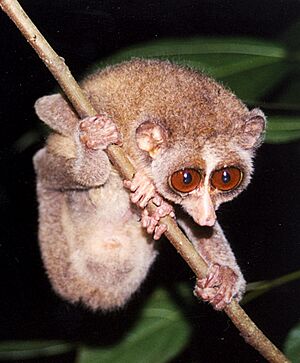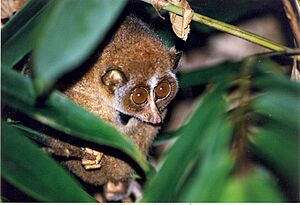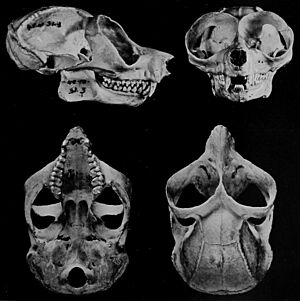Red slender loris facts for kids
Quick facts for kids Red slender loris |
|
|---|---|
 |
|
| Conservation status | |
| Scientific classification | |
| Genus: |
Loris
|
| Species: |
tardigradus
|
| Subspecies | |
|
|
 |
|
| Red slender loris range | |
| Synonyms | |
|
Lemur tardigradus Linnaeus, 1758 |
|
The red slender loris (Loris tardigradus) is a small, furry animal that lives in the rainforests of Sri Lanka. It is active at night, which means it's a nocturnal animal. This special loris is one of the most unique and endangered mammals in the world. Scientists call these animals 'EDGE species' because they are very different from other animals and are in danger of disappearing. There are two types, or subspecies, of the red slender loris.
Contents
What is a Red Slender Loris?
The red slender loris is a small, thin primate. It has big eyes that face forward, which help it see very well and judge distances. It also has long, thin arms and legs, and a special index finger. This loris does not have a tail. Its ears are large, round, and thin, with no fur on the edges.
Appearance of the Red Slender Loris
The fur of the red slender loris is soft and thick. It is reddish-brown on its back. Its belly is whitish-grey with some silver hairs. This animal is about 18 to 25 centimeters (7 to 10 inches) long. It weighs only about 85 to 368 grams (3 to 13 ounces).
Special Feet for Gripping
Each foot of the loris has a special four-way grip. Its big toe can move opposite to its other four toes. This allows it to hold onto branches and food like a pincer. The red slender loris also has a dark mask around its eyes with a pale stripe in the middle.
Different Types of Red Slender Loris
There are two main types of red slender loris. One type, L. tardigradus tardigradus, has a reddish-brown back and a creamy yellow belly. The other type, L. tardigradus nycticeboides, is dark brown on its back and very light brown on its upper parts.
Where Do Red Slender Lorises Live?
The red slender loris prefers to live in lowland rainforests. These forests can be found up to about 700 meters (2,300 feet) high in the wet parts of southwestern Sri Lanka. One important place where they live is the Masmullah Proposed Forest Reserve. This area is very important for many different kinds of plants and animals.
Their Favorite Food Spot
A plant called Humboldtia laurifolia is very common in these forests. It's a favorite food for the lorises. This plant is considered vulnerable, meaning it's also at risk. It has a special relationship with ants, and it provides a lot of food for the lorises. In the past, red slender lorises also lived near the coast, but they are not found there anymore.
How Red Slender Lorises Behave
Red slender lorises move quickly through the trees. They often form small groups with adult males, females, and young lorises. They are one of the most social animals that are active at night. During the day, they sleep together in tangled branches. They might also curl up on a branch with their heads tucked between their legs.
Social Life and Hunting
These groups also spend time grooming each other and playing. However, the adult lorises usually hunt for food alone at night. They mostly eat insects. They also enjoy bird eggs, berries, leaves, and buds. Sometimes, they eat small invertebrates like geckos and lizards. They eat every part of their prey, including scales and bones, to get all the nutrients.
Making a Home
Red slender lorises build nests from leaves. They might also find hollows in trees or other safe places to live.
Reproduction and Life Cycle
Female red slender lorises are usually in charge. A female can have babies when she is about 10 months old. She is ready to mate twice a year. These lorises mate while hanging upside down from branches. If they are kept in captivity, they won't have babies unless they have a good branch to hang from.
Baby Lorises
The mother carries her babies for about 166 to 169 days. After this, she will give birth to one or two young. The babies drink milk from their mother for about 6 to 7 months. In the wild, red slender lorises are thought to live for about 15 to 18 years.
Threats to Red Slender Lorises
The red slender loris is an endangered species. One of the biggest dangers is habitat destruction. This means their homes are being destroyed. People also trap and kill them because they believe the lorises can be used as medicine for eye diseases.
Other Dangers
Snakes, dogs, and some fish also hunt them. Other dangers include getting shocked by live electrical wires, being hit by cars on roads, and being caught to be sold as pets.
Conservation Efforts
The red slender loris was named one of the top 10 "focal species" in 2007. This was done by the Evolutionarily Distinct and Globally Endangered (EDGE) project. This project helps animals that are very unique and are in great danger.
Rediscovering a Lost Subspecies
One big success was finding the Horton Plains slender loris (Loris tardigradus nycticeboides) again. This subspecies was first seen in 1937. For over 60 years, people thought it was extinct. But in 2002, a team led by Anna Nekaris found it again in Horton Plains National Park. In late 2009, a team from the Zoological Society of London's EDGE program caught one. This allowed them to study it closely and take the first-ever photos. Scientists believe there might be only about 100 of these animals left. This makes it one of the most endangered primates in the world.
Images for kids





